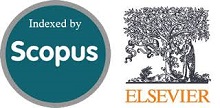Self-Healing Ability of High-Strength Fibre-Reinforced Concrete with Fly Ash and Crystalline Admixture
DOI:
https://doi.org/10.28991/cej-0309149Keywords:
Self-Healing, Fly Ash, Crystalline Admixture, SEM, FTIR.Abstract
The aim of this study is to analyse the self-healing capability of high-strength fibre-reinforced concrete (M70) with fly ash and crystalline admixture (CA) in four types of environmental exposures i.e. Water Immersion (WI), Wet-Dry Cycles (WD), Water contact (WC) and Air Exposure (AE). Specimens for four mixes are cast, one mix containing 1.1% of CA and three mixes with 10%, 20% and 30% partial replacement of cement with fly ash and additions of 1.1% CA. The specimens were pre-cracked at 28 days, in the range of 0.10-0.40 mm and the time set for healing was 42 days. The result shows that all the mixes have considerable amount of closing ability and strength-regaining capability for all exposure conditions. The concrete with 20% fly ash and 1.1% CA has complete crack closing ability and 100% strength-regaining capability for WI and WD cycle conditions. From SEM analysis, it is confirmed that self-healing products are CaCO3 and C-S-H gel.
References
[2] Wiktor, V. and Jonkers, H.M. (2011). "Quantification of crack-healing in novel bacteria-based self-healing concrete”, Cement and Concrete Composites.2011. 33(7). 763–770.doi:10.1016/j.cemconcomp.2011.03.012.
[3] Jonkers, H.M. and Schlangen, E. "Crack repair by concrete-immobilized bacteria”, Proceedings of the First International Conference on Self Healing Materials, Netherlands.2007, 18–20.
[4] Wang, J., Van Tittelboom, K., De Belie, N. and Verstraete, W. (2012). "Use of silica gel or polyurethane immobilized bacteria for self-healing concrete”, Construction and Building Materials.2012; 26(1): 532–540, doi:10.1016/j.conbuildmat.2011.06.054.
[5] Muhammad, N.Z., Shafaghat, A., Keyvanfar, A., Abd. Majid, M.Z., Ghoshal, S.K., Mohammadyan Yasouj, S.E., Ganiyu, A.A. "Tests and methods of evaluating the self-healing efficiency of concrete: A review”, Construction and Building Materials.2016; 112:1123–1132, doi:10.1016/j.conbuildmat.2016.03.017.
[6] Xu, J., Deng, H. and Shen, X. (2014). "Safety of Moxibustion: A Systematic Review of Case Reports”, Evidence-Based Complementary and Alternative Medicine. 2014; 1–10. doi:10.1155/2014/783704.
[7] Huang, H. and Ye, G. "A review on self-healing in reinforced concrete structures in view of serving conditions.”2014.available at: https://repository.tudelft.nl/islandora/object/uuid:bc600001-17ed-4a9b-8e47-b54226e17903?collection=research.
[8] Jonkers, H.M., Thijssen, A., Muyzer, G., Copuroglu, O. and Schlangen, E. "Application of bacteria as self-healing agent for the development of sustainable concrete”, Ecological Engineering.2010;36(2): pp. 230–235, doi:10.1016/j.ecoleng.2008.12.036.
[9] Gollapudi, U.K., Knutson, C.L., Bang, S.S. and Islam, M.R. "A new method for controlling leaching through permeable channels”, Chemosphere.1995;30(4):. 695–705, doi:10.1016/0045-6535(94)00435-W.
[10] Joseph, C., Jefferson, A.D., Isaacs, B., Lark, R. and Gardner, D. "Experimental investigation of adhesive-based self-healing of cementitious materials”, Magazine of Concrete Research.2010; 62(11): 831–843, doi:10.1680/macr.2010.62.11.831.
[11] Mihashi, H. and Nishiwaki, T. "Development of Engineered Self-Healing and Self-Repairing Concrete-State-of-the-Art Report”, Journal of Advanced Concrete Technology.2012;10(5): 170–184, doi:10.3151/jact.10.170.
[12] Rooij', M. de, Tittelboom, K. Van, Belie, N. De and Schlangen, E. "Self-Healing Phenomena in Cement-Based Materials: State-of-the-Art Report of RILEM Technical Committee 221-SHC”: Self-Healing Phenomena in Cement-Based Materials, Springer Netherlands, Netherland.2015.
[13] Van Tittelboom, K. and De Belie, N. "Self-Healing in Cementitious Materials”A Review”, Materials.2013; 6 (6):2182–2217, doi:10.3390/ma6062182.
[14] Dry, C. "Three designs for the internal release of sealants, adhesives, and waterproofing chemicals into concrete to reduce permeability”, Cement and Concrete Research.2000;30(12): 1969–1977, doi:10.1016/S0008-8846(00)00415-4.
[15] Pyerez, G., Jimenez, I., Erkizia, E., Gaitero, J.., Kaltzakorta, I. and Guerrero, A. "Effect of self-healing additions on the development of mechanical strength of cement paste”, Chemistry of Materials Research.2013;5: 102.105.
[16] Yang, Y., Yang, E.-H. and Li, V.C. "Autogenous healing of engineered cementitious composites at early age”, Cement and Concrete Research.2011; 41(2):pp. 176–183, DOI:10.1016/j.cemconres.2010.11.002.
[17] Miaomiao Hu, Jintang Guo, Yongjin Yu, Lei Cao and Yang Xu. "Research Advances of Microencapsulation and Its Prospects in the Petroleum Industry. Materials 2017; 10: 369; doi:10.3390/ma10040369.
[18] Jonkers, H.M. and Schlangen, E. "Crack repair by concrete-immobilized bacteria”, Proceedings of the First International Conference on Self Healing Materials, Netherlands.2007: 18–20.
[19] Yun Suk Lee & Woojun Park." Current challenges and future directions for bacterial self-healing concrete”. Applied Microbiology and Biotechnology 2017.
[20] K. Sisomphon, O. Copuroglu, E.A.B. Koenders, "Self-healing of surface cracks in mortars with expansive additive and crystalline additive”, Cem. Concr. Compos.2012; 34:566–574. doi: 10.1016/j.cemconcomp.2012.01.005.
[21] L. Ferrara, V. Krelani, M. Carsana, "A "fracture testing” based approach to assess crack healing of concrete with and without crystalline admixtures”, Constr. Build. Mater.2014; 68: 535–551. doi: 10.1016/j.conbuildmat.2014.07.008.
[22] M. Roig-Flores, S. Moscato, P. Serna, L. Ferrara, "Self-healing capability of concrete with crystalline admixtures in different environments”, Constr. Build. Mater.2015; 86 :1–11.doi:10.1016/j.conbuildmat.2015.03.091.
[23] M. Roig-Flores, F. Pirritano, P. Serna, L. Ferrara, "Effect of crystalline admixtures on the self-healing capability of early-age concrete studied by means of permeability and crack closing tests”, Constr. Build. Mater.2016; 114: 447–457. doi: 10.1016/j.conbuildmat.2016.03.196.
[24] Biricik, H. & Sarier, N., "Comparative study of the characteristics of nano silica - , silica fume - and fly ash - incorporated cement mortars”. Materials Research. 2014 ;17 (3): 570–582 doi: 10.1590/S1516-14392014005000054.
[25] Bjornstrom, J., Martinelli, A., Matic, A., Börjesson, L. & Panas, I. , "Accelerating effects of colloidal nano-silica for beneficial calcium–silicate–hydrate formation in cement”. Chemical Physics Letters.2004; 392 (1-3):242–248.doi: 10.1016/j.cplett.2004.05.071.
[26] American Society for Testing and Materials . C348-08: "Standard Test Method for Flexural Strength of Hydraulic-Cement Mortars”. West Conshohocken: ASTM International.
[27] Varas, M.J., Alvarez de Buergo, M. & Fort, R. "Natural cement as the precursor of Portland cement: Methodology for its identification”. Cement and Concrete Research.2005; 35 (11): 2055–2065.doi: 10.1016/j.cemconres.2004.10.045.
[28] Fernández-Carrasco, L. & Vázquez, E, "Reactions of fly ash with calcium aluminate cement and calcium sulphate”. Fuel. Fuel.2009:88; 1533–1538.doi: 10.1016/j.fuel.2009.02.018.
[29] Parande, A.K., Babu, B.R., Pandi, K., Karthikeyan, M.S. & Palaniswamy, N. "Environmental effects on concrete using Ordinary and Pozzolana Portland cement”. Construction and Building Materials.2011;25 (1). pp. 288–297. doi: 10.1016/j.conbuildmat.2010.06.027.
Downloads
Published
Issue
Section
License
- authors retain all copyrights - authors will not be forced to sign any copyright transfer agreements
- permission of re-useThis work (including HTML and PDF Files) is licensed under a Creative Commons Attribution 4.0 International License.







